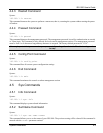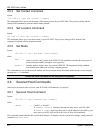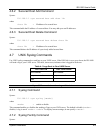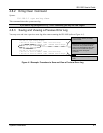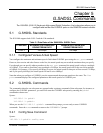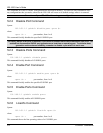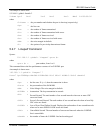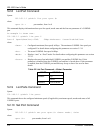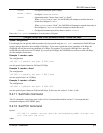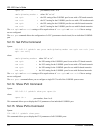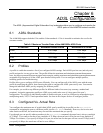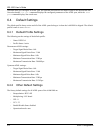
IES-1000 User’s Guide
G.SHDSL Commands 5-3
An example is shown next.
192.168.1.1 gshdsl> lineinfo 2
2=Down Sp=0 Tx=0 Tr=0 Rx=0 Rr=0 NM=0 T=000:00:00
where
<2=Down> =
the port number and whether the port is down/up (respectively).
<Sp> =
the line rate.
<Tx> =
the number of frames transmitted.
<Tr> =
the number of frames transmitted with errors.
<Rx> =
the number of frames received.
<Rr> =
the number of frames received with errors.
<NM> =
the noise margin in decibels.
<T> =
the uptime of a port in day:hour:minute format.
5.2.7 Lineperf Command
Syntax:
192.168.1.1 gshdsl> lineperf <port #>
where
<port #> =
port number, from 1 to 8
This command shows the line performance counters of an G.SHDSL port
An example is shown next.
192.168.1.1 gshdsl> lineperf 7
Port=7 Sp=2048kbps NM=0db ATTEN=0db ES=0 SES=0 LOSWS=0 UAS=0 downN=0
where
<Sp> =
the line rate. If Sp=0, then the connection is down.
<Port> =
the port number of the SAM1008.
<NM> =
Noise Margin. The noise margin in decibels.
<ATTEN> =
Attenuation. The loop attenuation in seconds.
<ES> =
Errored Second. The total number of one second intervals when one or more CRC
errors are found.
<SES> =
Severely Errored Second. The total number of one second intervals when at least fifty
CRC errors are found.
<LOSWS> =
Loss of Sync Word Failure Second. Displays the total number of one-second intervals
when one or more SHDSL LOSW errors are found.
<UAS> =
Unavailable Second. The total number of one-second intervals when the G.SHDSL
line is unavailable.
<downN> =
the number of times the G.SHDSL line has been dropped.



